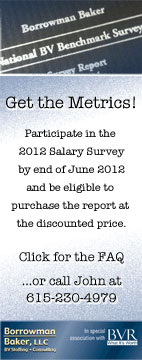
| June 27, 2012 | Issue #117-4 |
After a four-year partnership, NACVA and IBA become one Effective July 1, the Institute of Business Appraisers (IBA) will transfer all but a few assets to the National Association of Certified Valuators and Analysts (NACVA). In an announcement on Monday—which came right on the heels of the closing of its 2012 Consultants’ Conference in Dallas last week—NACVA said the merger will “ensure the longevity and success for both” organizations and achieve “greater economies of scale” than its partnership with the IBA four years ago. Under the proposed plan—unanimously approved by both the IBA and NACVA governing boards—the two organizations will fully merge, with the IBA retaining its CBA and MBCA credentials in a separate entity (the “new” IBA), but transferring the remainder of its assets, including its ABAR and BVAL credentials, to either NACVA or a new division of NACVA, to be known as the Appraisal Database and Mentoring Services (ADAM). The IBA’s ABAR credential will remain intact, but its BVAL credential will be merged into NACVA’s CFFA credential within three years, and the recertification cycle for both credentials will change from two to three years, following the NACVA model. The new IBA, comprising only CBAs and MCBAs, will continue to administer the applicable unified professional standards and rules of professional conduct. As a result of the merger, “the IBA, with its rich history of contributions to the valuation profession, will retain its legacy for all that it has achieved,” NACVA said in its announcement to members. For more information, contact Howard Lewis at hlewis@iba.org or Sheila Travis at shelaat1@nacva.org. ‘BV credentials don’t matter,’ says Abraham—at least, not when building a multimillion dollar practice One of the biggest “myths” about marketing a BV practice is that all the practitioner needs is a designation (or several designations) from any of the major BV professional credentialing organizations. “Your qualifications are critical,” explained Mel Abraham in his keynote address to the 2012 NACVA Consultants’ Conference in Dallas last week. But since all appraisers must have the appropriate credentials to practice their valuation skills, “your particular qualifications don’t matter to the marketplace or your position within it,” he said. Your designations don’t differentiate you—or help create a seven-figure practice. “It’s the experience you have and the results you get that matter.” Market positioning is the key to debunking the other big BV marketing myths, such as “there’s too much competition” or “it takes too much time” to build a successful BV business. Sure, it takes time, effort, and the proper education, tools, resources, marketing practices, and—perhaps most important—professional mentors. But the impediments to building a wildly successful practice are not a surfeit of competitors or a dearth of client referrals. Abraham said, “It’s all about positioning yourself in the marketplace,” and then creating the right perception and promotion of your particular proficiencies. In his NACVA address, Abraham offered a cornucopia of practical tips for appraisers to engage their intended audience—including how to use the Internet, email, direct mail, video resources, and publishing and speaking opportunities. Look for a complete discussion of how to build a BV business that serves “society, community, and your life” in the August 2012 issue of Business Valuation Update. Survey: How do you use and apply market data? After the Tax Court’s decision in Gallagher v. Commissioner and its rejection of the four comparable companies used in the guideline public company analysis by the taxpayer’s expert, “is the market approach even valid anymore?” asked Bob Grossman (Grossman Yanak & Ford) at the recent NACVA conference in Dallas. “I think so,” he said, but Gallagher has prompted the profession to take a closer look. In teaching the market method in BV courses, Grossman uses the example of trying to value a 1960s Corvette. “If [that same model] is selling for $75,000 on the market, then that’s its [market] value,” he believes. “But the problem in BV is the lack of direct comparability. There’s a broad spectrum of methodology that we apply to try and bring [the analysis] down to the same degree of comparability, but the courts are looking for a degree of comparability in the data—at least in tax cases—that doesn’t exist.” How do you currently use the market databases? Do you routinely consider applying private transaction data as well as guideline public company data to reach a market value for a subject company? If not, why not? And in applying the income approach, do you still derive ERP, size premium, and other inputs to the WACC and capital structure from guideline public company comparables? We’d like to find out more about appraisers’ current application of the market approach and their reliance on the various data sources in this quick, eight-question online survey. We’ll publish the results in the next issue of BVWire. No new guidance yet on FLP appeals or appraiser penalties—but, hey, you can now ‘friend’ the IRS RPO and get tweets! When is the long-anticipated guidance on Sec. 6695A appraisal/appraiser penalties coming from the IRS? That was among the first questions lobbed to the panel of presenters on tax-related valuation topics at the NACVA conference. “There’s no manual done yet,” reported Sue Kurzweil, a national business valuation issue coordinator with the IRS. “It’s in the works, but I don’t know when the guidelines will be issued,” she said. A similar question regarding the long-awaited update to the Appeals Settlement Guidelines (ASG) for family limited partnerships didn’t come up during the NACVA sessions, but we’re tracking all important guidance and appraiser initiatives from the IRS. For instance: Last week, the tax service did announce that its Return Preparer Office (RPO) is now on LinkedIn as well as on Facebook and Twitter. “To better communicate with and support the tax professional community,” the RPO will use the social media sites to post the latest changes on competency testing, qualifications, and renewals. Finally, we did learn from William Cousins III (Meadows Collier Reed Cousins Crouch & Ungerman), the attorney who tried Keller v. United States (S.D. Tex. 2009), that he just argued the appeal in that case to the 5th Circuit in March and a decision is imminent. In the meantime, if you want to review the original Keller decision, in which the federal district court adopted the taxpayer’s roughly 48% in discounts, the case digest and court’s opinion are currently available at BVLaw. Final, final, final chance to participate in BB/BVR salary survey OK, this time we really mean it! The deadline for participating in the Borrowman Baker/BVR Business Valuation Salary Survey is this Friday, June 29. There will be no more extensions—and no more excuses. The BB/BVR Report will only be as robust as you make it by contributing the data from your practice. Help the BV profession build its only current, comprehensive, and credible database of compensation data—and get your copy of the complete results, too. Click here to go to the Welcome Page and get started. SEC releases ‘road map’ for phasing in rules on derivatives This month, the Securities and Exchange Commission (SEC) issued a policy statement describing the order in which it expects to implement new rules regulating the derivatives market. “The statement covers final rules to be adopted by the SEC under the 2010 Dodd-Frank Wall Street Reform and Consumer Protection Act,” according to the SEC press release, which also contains a link to the policy statement as well as the comments page. “The policy statement seeks to provide a ‘road map’ to market participants and the public on how we expect to implement the various regulatory requirements for this market,” said SEC chair Mary Schapiro in the release. “We look forward to public comment on our anticipated sequencing as we continue to adopt and implement the rules under the law.” Public comments will be due 60 days after the policy statement is published in the Federal Register. Look before you LEAP into marketability discounts Sorry, we couldn’t resist the (bad) pun. We just wanted to call your attention to our next webinar LEAPS and the DLOM, on July 12. Join Ronald Seaman (DLOM Inc.), author of the book LEAPS and the DLOM, as he explains the methodology and best practices of applying LEAPS methodologies to determine a discount for lack of marketability. Seaman’s presentation will also review the results of the fourth and latest LEAPS study and will cover DLOM methodology in general as well as the impact of the current economy on deriving marketability discounts. And if you want to check out Seaman’s new book, click here now. A special bundled price is available for the book and webinar combo: Check it out here. ‘Tantalizing’ evidence doesn’t always equate to statistical accuracy Despite the “tantalizing headline” in last week’s issue of BVWire—the item that tracked divorce decisions in the BVLaw database by SIC code, implying that healthcare professionals may be more prone to litigation—“it is disingenuous to suggest a conclusion from an analysis of a clearly nonrepresentative sample,” writes Michael Molder (Marcum) “The population you are using for your metric suffers from self-selection bias,” which does not necessarily represent the total population of divorces, he points out. We totally agree with Molder’s analysis and appreciate (as always) the astute, empirically grounded observations from our well-educated audience. Still, we are left scratching our heads to explain why, for instance, in the past 18 months alone, there have been eight (8) published appellate decisions concerning a dental practice valuation in divorce—far outnumbering any other profession, in healthcare or other fields. Our search by SIC code was just a nonscientific way to try to get some context for the anecdotal evidence. What are your thoughts? Are some professionals more prone to divorce litigation than others? What are you seeing in your practice? Email any thoughts, scientific, statistical, or just plain subjective, to the ever-inquiring BVWire editor. More ‘live from NACVA’ news Follow all the latest news from the 2012 Consultants’ Conference—reported in “real time” from the ballrooms of the Omni Dallas hotel—at the BVWire News blog, including a live post on discounts and premiums and another on adjusting for risk in the income approach. ASA announces 2012 election results The American Society of Appraisers (ASA) has just announced the results of its 2012 elections. Among the winners—who will take office July 1—are Daniel Van Vleet, the new president of the International Officers, and James Brown, Kenneth Pia, Timothy Meinhart, and Trey Stevens, all new members of the BV Discipline Committee. The entire slate of newly elected officials comprises “a prestigious group of professionals that have consistently demonstrated their support and dedication to the mission of ASA and its members,” says Jack Washbourn, the ASA’s international president. “We commend these individuals and appreciate their service. We wish them all the best in their new positions.” For complete ASA election results, click here. Holiday Hiatus BVWire will be taking a brief break for the July 4 holiday next week; we will resume publication on July 11, 2012. Have a safe, restful summer break!
To ensure this email is delivered to your inbox, please add editor@bvwire.com to your e-mail address book. We respect your online time and privacy and pledge not to abuse this medium. To unsubscribe to BVWire™ reply to this e-mail with 'REMOVE BVWire' in the subject line or use the link below. This email was sent to %%emailaddress%% Copyright © 2012 by Business Valuation Resources, LLC |
|



